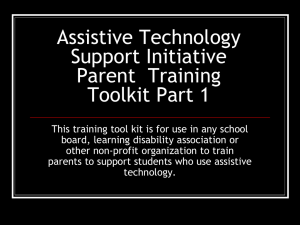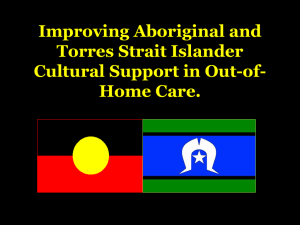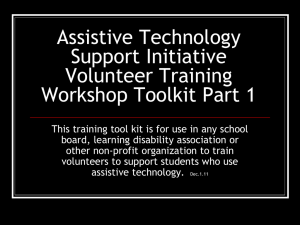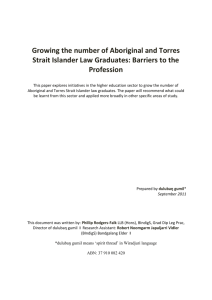Paper-No-28-Katie-Maher-2012
advertisement
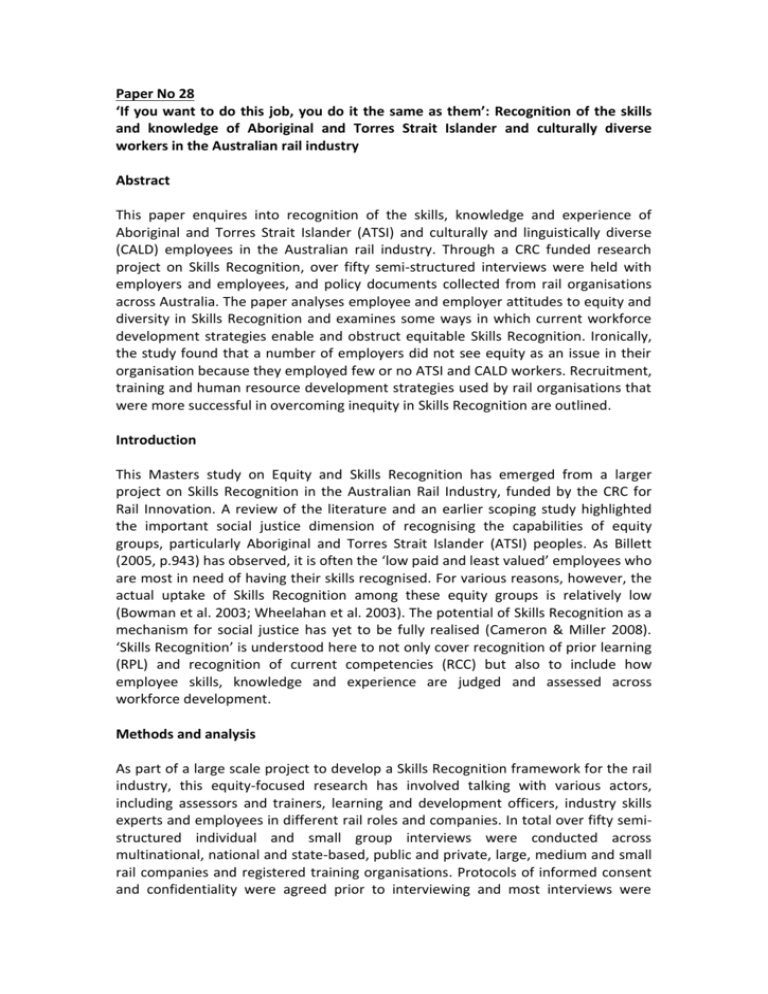
Paper No 28 ‘If you want to do this job, you do it the same as them’: Recognition of the skills and knowledge of Aboriginal and Torres Strait Islander and culturally diverse workers in the Australian rail industry Abstract This paper enquires into recognition of the skills, knowledge and experience of Aboriginal and Torres Strait Islander (ATSI) and culturally and linguistically diverse (CALD) employees in the Australian rail industry. Through a CRC funded research project on Skills Recognition, over fifty semi-structured interviews were held with employers and employees, and policy documents collected from rail organisations across Australia. The paper analyses employee and employer attitudes to equity and diversity in Skills Recognition and examines some ways in which current workforce development strategies enable and obstruct equitable Skills Recognition. Ironically, the study found that a number of employers did not see equity as an issue in their organisation because they employed few or no ATSI and CALD workers. Recruitment, training and human resource development strategies used by rail organisations that were more successful in overcoming inequity in Skills Recognition are outlined. Introduction This Masters study on Equity and Skills Recognition has emerged from a larger project on Skills Recognition in the Australian Rail Industry, funded by the CRC for Rail Innovation. A review of the literature and an earlier scoping study highlighted the important social justice dimension of recognising the capabilities of equity groups, particularly Aboriginal and Torres Strait Islander (ATSI) peoples. As Billett (2005, p.943) has observed, it is often the ‘low paid and least valued’ employees who are most in need of having their skills recognised. For various reasons, however, the actual uptake of Skills Recognition among these equity groups is relatively low (Bowman et al. 2003; Wheelahan et al. 2003). The potential of Skills Recognition as a mechanism for social justice has yet to be fully realised (Cameron & Miller 2008). ‘Skills Recognition’ is understood here to not only cover recognition of prior learning (RPL) and recognition of current competencies (RCC) but also to include how employee skills, knowledge and experience are judged and assessed across workforce development. Methods and analysis As part of a large scale project to develop a Skills Recognition framework for the rail industry, this equity-focused research has involved talking with various actors, including assessors and trainers, learning and development officers, industry skills experts and employees in different rail roles and companies. In total over fifty semistructured individual and small group interviews were conducted across multinational, national and state-based, public and private, large, medium and small rail companies and registered training organisations. Protocols of informed consent and confidentiality were agreed prior to interviewing and most interviews were audio-taped and transcribed. A project steering committee comprised of representatives from participating rail companies assisted with selecting interviewees and arranging interviews. While the initial informants interviewed for the wider project included a range of men and women, to our knowledge few were from non-English speaking background and none were Aboriginal or Torres Strait Islander. In order to better inform equity and diversity concerns, two equity and diversity officers, the Aboriginal manager of an Indigenous contracting company, and a network of ATSI rail employees were later consulted and further consultation is planned. The methodology included thematic analysis of interviews and discussions and textual analysis of policy and strategy documents. Interview transcripts, notes and discussions were analysed to explore emerging themes. This was combined with a critical textual analysis of relevant company strategy and policy documents to locate gaps and consolidate findings. Jonsen and Jen (2009) reflect on how, when viewing qualitative studies, ‘we often end up asking the question; how did the researcher arrive at these concepts? (as opposed to a different set of concepts)’ (p.124). As Ahmed et al (2006, p.23) have said, ‘it is challenging to research processes that may be on the surface hidden’. This study has attempted to locate aspects of Skills Recognition and equity that are, in part, concealed. Beyond gathering data on how Skills Recognition, equity and diversity are promoted by the rail industry, the aim is to learn what is not said about Skills Recognition processes and what is not written into policy and strategy documents, to ‘go beyond how organisations ‘imagine’ themselves as being diverse to see the effects of this self-imagining.’ (Ahmed, 2006, p.23). The analysis is informed by the theoretical frameworks of decolonising inquiry (Denzin, Lincoln & Smith, 2008; Smith, 1999; Nakata, 2007) and grounded on histories of ATSI employees in rail (Maynard, 2001; Taksa & Groutsis, 2010; Moran, 2004; Ah Chee, 2000). This grounding provides the foundations for identifying less recognised aspects of equity and Skills Recognition. As early findings have revealed particular concerns around undervaluing of the skills, knowledge and experiences of ATSI peoples, equity issues for ATSI employees are the main focus of this paper. The paper analyses employee and employer attitudes to equity and diversity in Skills Recognition and examines some ways in which current workforce development strategies enable and obstruct equitable recognition of the skills, knowledge and experience of ATSI and CALD employees. 1. The problem of not seeing equity as a problem This research exposes not only what is said, but what is not said regarding equity in Skills Recognition. Many non-ATSI interviewees, regardless of the type of rail company they came from or their role within that company, did not claim to have equity concerns around Skills Recognition. Equity groups, including ATSI and CALD employees, were considered to have ‘equal’ or ‘the same’ access to Skills Recognition. When asked about risk and opportunities in Skills Recognition, what makes a good assessor or what should be included in a Skills Recognition framework, equity was rarely mentioned. Furthermore, some employers did not see equity implications in Skills Recognition of ATSI applicants or employees because they employed few or no ATSI workers. The possibility that low ATSI employment might be related to insufficient recognition of ATSI capabilities was not usually acknowledged. Those interviewees who did recognise that equity problems existed tended to be from companies that were more successful in employing and engaging ATSI employees, but even within given companies there were different perceptions around equity. 2. Treating everyone ‘the same’ While some interviewees saw the value in specific recruitment, promotion and Skills Recognition assessment strategies for equity groups, there was a widely-held assumption among non-ATSI interviewees that ATSI and CALD workers should be treated ‘the same’ and little acknowledgment of the need for equity initiatives. When asked whether everyone had the same opportunity to undergo RPL, one trainer from a national rolling stock manufacturer commented: I’m giving the same information to everybody, so it’s got nothing to do … if you’re employed by us, because we have these standards, practice and procedures that we go through …You are going to come into our system and you are going to go across these hurdles, and it doesn’t matter who you are. The assumption that standard practice and procedures that were ‘the same for everyone’ somehow ensured equity for all was heard from interviewees in various roles. This suggested a lack of acknowledgement of how wider structural inequalities can disadvantage equity groups which are less familiar with mainstream practices. 3. The under-representation of ATSI employees Rail company reports suggest ATSI employee figures range from zero to more than 3%. In most rail companies, the representation of ATSI employees was comparatively low when compared with ATSI representation in the general population. ATSI peoples comprise an estimated 2.5% of the total Australian population (Australian Bureau of Statistics, 2007). As ATSI Australians have a proportionally higher representation in regional and remote areas, the percentage of ATSI peoples may be considerably higher in the regions where rail companies are currently operating. Several of the interviewees we spoke with, from both private and public rail companies, stated there were no or few ATSI employees in their companies. Interview data and annual reports from select rail companies suggest that ATSI employees are still concentrated in lower paid, ‘low grade’ positions. According to interviewees, ATSI employees were more likely to be in infrastructure roles and customer service roles. The following table indicates ATSI employment figures and initiatives across select rail companies. Table 1: ATSI employment figures and initiatives of select rail companies Company type ATSI ATSI employment initiatives include: Employees A. Large state passenger rail service 2.1% ATSI employee networks; Equity and diversity officer; Aboriginal liaison officers; Preapprenticeship program; ATSI apprenticeships & cadetships B. Small state passenger rail service 0.4% Currently no ATSI employment strategies; Plans to develop aboriginal engagement strategy 2% Reconciliation Action Plan; Aboriginal liaison officers; Indigenous recruitment and retention strategy; ATSI employee leave entitlements C. Small-medium state passenger rail service D. Large passenger rail and infrastructure company 1.97% To develop Indigenous employment strategy, To appoint strategic Indigenous advisor E. Small international freight company operating across states 0 Currently no targeted Indigenous employment strategy; Recent consultation with Indigenous advisory board F. Large private rail infrastructure company operating across states 3% Reconciliation Action Plan; ATSI development managers; cultural learning pathway for non-ATSI employees; mentoring; ATSI engagement approach Findings so far suggest that those companies committed to Indigenous engagement strategies which support more equitable Skills Recognition for ATSI applicants and employees have higher ATSI attraction and retention rates. Such strategies include: programs preparing applicants for recruitment and related testing; ATSI support networks; equity advisory boards with ATSI representation; and the employment of ATSI development managers. 4. More skilled than ‘low skilled’: Valuing ATSI and CALD capabilities It was apparent that for many companies, ATSI applicants faced barriers when they applied for positions and some ATSI and CALD applicants struggled to demonstrate their skills via standard recruitment and testing processes. When asked whether they employ ATSI people, the training and assessment manager from one freight company replied, They just don’t pass, they just don’t get past the psychometric testing, they just don’t make it unfortunately. A number of current initiatives are acting to strengthen recognition of ATSI and CALD capabilities. As an example, a recruitment and assessment manager from a state rail service with an equity and diversity management plan in place explained how preemployment strategies were working to expand recognition of Indigenous capability: We do specifically target the Indigenous community. We do a special apprenticeship campaign … And we also do what we call a pre-apprenticeship campaign. We find that, because we do job-related testing, we find that that particular community have a lot of trouble getting through the testing, because they’re not used to a testing environment, so we run what’s called a pre-apprenticeship campaign, and so we work with them to get them comfortable using tests and practising tests and, you know, and being in that sort of environment under that sort of time limit. Many rail companies, however, do not present such opportunities. Past the recruitment stage, the capability of ATSI employees may be undervalued such that they are placed in roles that do not make best use of their skills. A manager of an Indigenous contracting company explained how a number of ATSI construction trainees had gained work with a rail contracting company. The trainees were, however, given monotonous tasks that required very little skill. These trainees, initially very keen to work in roles that made use of their skills and which provided opportunities for further skills development, were dissatisfied with this dull and repetitive work. According to Norris (2010, p.180), ‘No studies have actually examined the level and nature of skills held by Indigenous people, but claims are consistently made that the reason for Aboriginal lack of employment is their lack of skill’. Furthermore, when ATSI applicants do gain employment, assumptions about lack of capability can lead to ATSI employees being placed in roles that do not make best use of their skills and which discourage retention. Norris’ (2006, p.243) work on ATSI employment disadvantage points to a ‘continuing lack of respect for Aboriginal culture, people, perspectives and skills … which then becomes a reason for confining aboriginal people to low skill, low paid jobs on reduced pay and conditions’. Norris (2010, p.180) suggests that behind this concentration in low skilled positions is a belief that ATSI peoples ‘lack the requisite skills to occupy a higher proportion of skilled positions in the workforce’ and an avoidance of the likely explanation ‘that only low skilled jobs are generally available’. A workplace trainer and assessor from one interstate freight company, when asked if equity was an issue in training and assessment of ATSI and CALD workers, replied: It certainly is, and that’s where the equity is not just there, we do have a lot of Indigenous people … and they are not given a fair chance to get through the processes... They can do the job by displaying it to you, yeah. ATSI employees may face barriers in applying for internal positions and getting through the processes that enable promotion to higher level positions. One experienced ATSI customer service employee from a state passenger rail organisation explained how the completion of excessive paperwork was a requirement for applying for a more senior position. While she was confident in her ability to take on a more senior role, she was discouraged by the application process. Requirements for written forms of assessment and standards around what constitutes acceptable evidence of skills and experience were noted as barriers to ATSI and CALD applicants and employees gaining Skills Recognition. As Constable et al. (2004, p.13) explain, candidates may name their capabilities in ‘culturally specific ways that do not necessarily lend themselves to be used in job application processes … Consequently, these skills, qualifications and experience remain unrecognised and are lost to the labour market, and individuals are often forced to work below their level of skills and expertise with the attending social and psychological effects’. A learning and development manager from a large national freight operator noted that standard assessment practice in the rail industry could prevent some ATSI employees from gaining Skills Recognition and suggested that rail learn from industries that use more flexible non-paper based approaches: the limited knowledge of how you can do this process even though numeracy and literacy is a problem. An example I give is that if you once again look at other industries, people don’t always have to answer questions in a written way. People don’t always have to read a question, you can ask a person a question and that person can demonstrate quite clearly that they have the knowledge, then you should recognise it. Because recruitment, assessment and promotion procedures often treat all applicants ‘the same’, some ATSI employees in rail struggle to access skilled employment opportunities. Positions specifically targeting ATSI peoples tend to be in entry level, low grade and low paid positions. ATSI engagement strategies may be overlooked in leadership and management development within rail organisations. Existing RPL research suggests that ATSI candidates do not access and benefit from Skills Recognition programs to the same extent as non-ATSI candidates (Kemmis et al., 2004). Early findings of this study suggest that this may also be the case in rail. 5. Working with the ‘Rail Language’ One learning and development coordinator from a state passenger rail service noted that no particular issues had come up with ATSI or CALD employees at her company. When asked whether the language used in Skills Recognition might be problematic for some employees she replied, ‘It possibly could be but I’ve not come across it yet, because we work on the rail language here’. Comments from other interviews have however indicated that ‘the rail language’ is not without its equity issues. A workforce development officer from a large national freight operator, when asked, ‘Is equity much of an issue in Skills Recognition?’ answered, ‘I don’t feel it is, but that’s just my opinion’. When asked if the ATSI and CALD employees she worked with faced any particular difficulties she responded: There was a couple of migrants that didn’t understand the process, what we were doing. … and trying to explain to them that we are trying to recognise the skills that they had … and again with the Indigenous exactly the same thing. ‘I’ve been doing this job for forty years, why should I have to answer these questions, aren’t I doing my job, don’t you like what I’m doing?’ … we had to prove it to them, that everybody across the board, including myself had to go through the RCC process, so we are not just picking on you or you, everybody has got to do it. ‘But I don’t understand why’, and trying to explain to them why, was a very difficult thing. An external trainer and assessor from an interstate rail service noted that he found it difficult to fairly assess the competencies of ATSI and CALD employees: Some of them had a hard time proving to me that they had (skills and experience), both migrant and Indigenous … Could be cultural differences, maybe I missed some of their subtle movements that I didn’t pick up, but yeah I did have a hard time trying to get it out of some of them. Our research identified a lack of confidence or expertise in engaging with ATSI and CALD employees in some companies, suggesting that miscommunication could obstruct effective Skills Recognition. A learning quality and accreditation manager from a large state passenger rail and infrastructure company observed that one risk with skills assessment in rail is that: we might not have the people in-house that have that background knowledge and understanding to recognise those skills in others or we might employ people to do that who have that background knowledge, for instance an external provider. I would see that as a risk, that there might be some misalignment between the worker’s skills they are demonstrating and the perception of what those skills are. An employee from one state rail company voiced concern that none of the people involved in recruitment, assessment and training were Indigenous. This interviewee felt that there was a need to appoint a suitably experienced ATSI employment and engagement manager, but as there were so few ATSI employees the company was not prepared to cover the cost. 6. The equity case for diversity: Skills Recognition in ATSI engagement strategies Valuing equity in Skills Recognition also requires an approach to diversity that is not restricted to the ‘business case’. According to Squires (2006, pp.14-15) valuing diversity entails ‘awareness, education and positive recognition of the difference among people’ with initiatives focusing on ‘the quality of the work experience’. This contrasts with the ‘business case’ for diversity, which is ‘a strategic approach to business that contributes to organizational goals such as profits and productivity’ and does not entail legal requirements. Squires observes that the business case for diversity is ‘severed from the histories of wider structural and cultural inequalities … it obscures the sources of the differences it seeks to exploit, focusing on the characteristics of employees or applicants rather than the structures that create and perpetuate these characteristics’ (Squires, 2006, p.27). Indeed, current models of diversity management might emphasise sameness rather than value diversity: (D)iversification of the workforce may create institutional tensions rather than increased productivity, in which case the pragmatic business case for diversity loses its purchase. Alternatively, diversity management may be employed selectively in relation to certain social groups and not others if representatives of particular groups are perceived to offer greater business advantages than others, in which case ‘diversity’ would undermine rather than increase equality between groups. It may also entrench cultural stereotypes … To the extent that it relies on such assumptions, diversity management paradoxically affirms sameness. (Squires, 2006, pp.27-28). Diversity can present opportunities for Skills Recognition in relation to how companies work with notions of capability and performance. According to Squires (2006), an approach that values diversity can allow for a more comprehensive understanding of capability that is inclusive of equity groups. Rather than focusing on ‘credentials’, which Squires (2006, p.24) suggests are ‘a weak predictor of performance in many cases’, there is a need for a more open and expansive conception of what skills, knowledge and experience are required of a capable employee. According to the equity and diversity plan of one large private interstate rail operations company, ‘Diversity of experience, background and gender enhances the quality and robustness of decision-making’. Early conclusions Current Skills Recognition policies and practices present both opportunities and barriers to recognising the capabilities of ATSI and CALD employees. Recognition is constrained by assumptions including: that equity is not an important issue; that everyone is treated the same; that if everyone is treated the same then no one is disadvantaged; that ATSI applicants and employees are ‘low skilled’; and that standards and regulations are fair for all. Some employers and assessors did not see equity as an issue because they had so few ATSI and CALD employees. While rail companies may set overall targets for employment percentage figures for equity groups including ATSI, most rail companies do not have targets for ATSI employment in better paid positions that require recognition of higher level skills. According to Norris (2010, p.181), if we recognised the capabilities of ATSI employees: we would support the creation of jobs to service Indigenous communities throughout Australia to a level commensurate with what the rest of us expect. We would ensure that all these jobs were open to Aboriginal people, that already existing skills of indigenous people were acknowledged and valued… Beneath this is the recognition of ATSI land custodianship, which in turn leads to an appreciation of how ATSI peoples have in fact made a very strong contribution to the rail industry labour force. As Matson-Green and Harper (1995, p.65) remind us, Aboriginal peoples: ‘historically, have contributed more to the labour force and the economic development of their ‘country’ than any other group. Whether by choice or force, Aboriginal nations have contributed their land, on which all economic development ultimately depends’. Acknowledgement The author is grateful to the CRC for Rail Innovation (established and supported under the Australian Government's Cooperative Research Centres program) for the funding of this research through Project P4.111 A Skills Recognition Framework for the Rail Industry. References Ah Chee, A. 2000. Transcript of interview with Arthur Ah Chee recorded by Jane Munday at Alice Springs, 26 Nov 2000. Northern Territory Archives Service Oral History Unit. Ahmed, S; Hunter, S; Kilic, S; Swan, E and Turner, L. 2006. Race, Diversity and Leadership in the Learning and Skills Sector, Final Report, November 2006, Centre for Excellence in Leadership, Lancaster University. Australian Bureau of Statistics. 2007. Population Distribution, Aboriginal and Torres Strait Islander Australians 2006, No. 4705, ABS,Canberra. Barbour, R. S. & Kitzinger, J. 1991. ‘The challenge and promise of focus groups’, Kitzinger & Barbour (Eds.) Developing Focus Group Research: Politics, Theory and Practice. Sage, London Billett, S. 2005. ‘Recognition of learning through work’, in Springer International Handbook of Educational Policy, vol. 13(2), eds. N Bascia, A Cumming, A Datnow, K Leithwood & D Livingstone, Springer, Great Britain, pp. 943-962. Bowman, K., Clayton, B., Bateman, A., Knight, B., Thomson, P., Hargreaves, J., Blom, K., Enders, M. & National Centre for Vocational Education Research. 2003. Recognition of prior learning in the vocational education and training sector. Cameron, R. & Miller, P. 2008. ‘A transitional model to assist those experiencing labour market disadvantage’, paper presented at the 17th Annual Australian Association of Career Counsellors Conference, Hobart, 26-28 March. Constable, J., Wagner, R., Childs, M. & Natoli, A. 2004. Doctors become taxidrivers: Recognising skills -not as easy as it sounds, Office of Employment, Equity and Diversity, NSW. Denzin, N. K., Lincoln, Y. S. & Smith, L T. (eds) 2008. Handbook of Critical and indigenous methodologies, SAGE. Department for Transport, Energy and Infrastructure, SA. ‘Aboriginal engagement strategy – Adelaide metro’ Aboriginal engagement strategy 2007-2010. Looking forward looking back: from assimilation to reconciliation. Gordon, H. & Wanganeen, K. 2008. RPL Mentoring Project Final Report: December 2008, A collaborative approach to Skills Recognition for Aboriginal people by the Commissioner for Aboriginal Engagement, DFEEST’s Aboriginal Employment Initiatives, TAFE SA Regional and Aboriginal Access Centre. Jonsen, K. & Jen, K. 2009. ‘Using triangulation to validate themes in qualitative studies’, Qualitative Research in Organizations and Management, Vol. 4 No. 2, pp. 123-150. Kemmis, S., Atkinson, M., Brennan, R. & Atkinson, C. (2004). Partners in a Learning Culture: Blueprint for implementation: Mid-term review: Final report. Brisbane, QLD: ANTA. Lui-Chivizhe, L. 2011. ‘Making history: Torres Strait Islander railway workers and the 1968 Mt Newman track-laying record’, Aboriginal History, vol. 35, pp. 37-55. Matson-Green, V & Harper, T. 1995, ‘Palawa women: carrying the burdens and finding the solutions’, Aboriginal Workers, Labour History, no.69, pp.65-74. Maynard J. 2001. ‘Muloobinbah (Newcastle) an Aboriginal industrial presence: past and present’, Journal of the Royal Australian Historical Society, 87, pp.248266. Moran, C. 2004. Talk softly, listen well: profile of a Bundjalung elder Charles Moran as told to Glennys Moran, Southern Cross University Press, Lismore. Nakata, M. 2007. ‘The cultural interface’, Australian Journal of Indigenous Education, vol. 36, Supplement: Recontesting Indigenous knowledges and Indigenous studies, pp.7-14. Norris R. 2006. The more things change ...: continuity in Australian Indigenous employment disadvantage 1788-1967. Unpublished Doctor of Philosophy thesis, Griffith University, Brisbane. Norris, R. 2008. ‘Using history as an evaluation tool’, Paper presented to AES Seminar Brisbane, 21 February 2008. Norris, R. 2010. The more things change-: the origins and impact of Australian Indigenous economic exclusion, Post Pressed: Queensland. Smith, L. T. 1999. Decolonising methodologies: Research and Indigenous Peoples, Zed Books, UK. Squires, J. 2006. ‘Equality and Diversity Policy Frames: Intersectionality and Diversity Management’. Presented at the Conference Revisiting Governance from Feminist and Queer perspectives, 29 June 2006, University of Kent, UK Taksa, L. & Groutsis, D. 2010. ‘Managing Diverse Commodities: From Factory Fodder to Business Asset’, Economic and Labour Relations Review, Vol. 20, No. 2, pp. 77-98 Wheelahan, L., Dennis, N., Firth, J., Miller, P., Newton, D., Pascoe, S. & Veenker, P. 2003. A report on Recognition of Prior Learning (RPL) policy and practice in Australia in 2002, including national principles and operational guidelines for RPL in post-compulsory education and training.

